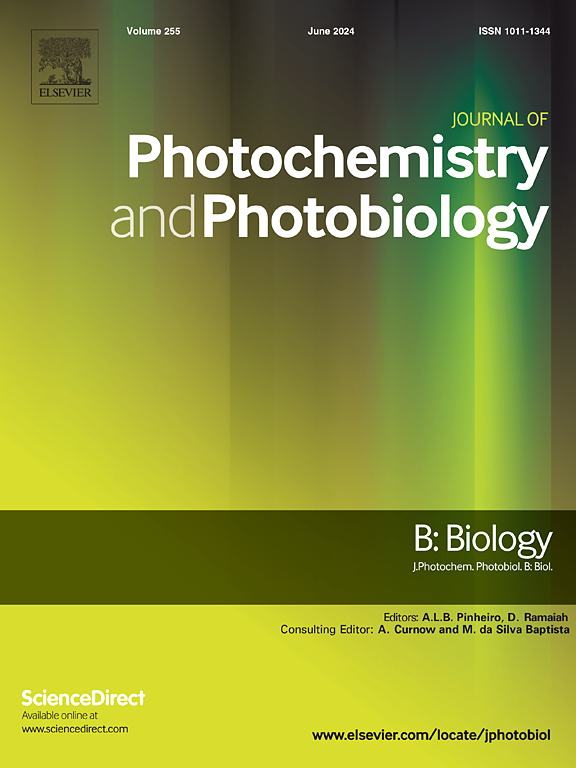Natural-synthetic hybrid nanoparticles: Polydopamine-Phycocyanin composites for enhanced antibacterial phototherapy against bacterial pathogens
IF 3.9
2区 生物学
Q2 BIOCHEMISTRY & MOLECULAR BIOLOGY
Journal of photochemistry and photobiology. B, Biology
Pub Date : 2025-07-10
DOI:10.1016/j.jphotobiol.2025.113222
引用次数: 0
Abstract
The rapid rise of antibiotic-resistant bacterial infections demands innovative, non-antibiotic strategies to combat pathogens without driving further resistance. In this study, we developed polydopamine-coated phycocyanin nanoparticles (PDA@PC) by encapsulating the natural antioxidant phycocyanin (PC) within a polydopamine (PDA) matrix. These nanoparticles (146 nm) combine PDA's photothermal and photodynamic properties with PC's antioxidant activity, enabling dual-mode antibacterial action under near-infrared (NIR) laser irradiation. PDA@PC demonstrated excellent biocompatibility (>70 % cell viability) and blood compatibility (<5 % hemolysis), outperforming PDA alone at high doses. Under laser exposure, PDA@PC generated heat and reactive oxygen species (ROS), achieving >50 % inhibition of bacterial biofilms and significant reductions in colony counts for Staphylococcus aureus and Pseudomonas aeruginosa. The nanoparticles also showed enhanced antibacterial efficacy against S. aureus, with minimal inhibitory concentrations (MIC) comparable to conventional antibiotics. By doubling the catechol content of PDA, PDA@PC amplified ROS production while mitigating oxidative stress, offering a safe and effective platform for treating resistant infections. This work highlights the potential of PDA@PC as a multifunctional, laser-activated nano therapy to replace traditional antibiotics and combat the global antimicrobial resistance crisis.

天然合成混合纳米粒子:聚多巴胺-藻蓝蛋白复合材料增强抗菌光疗对抗细菌病原体
抗生素耐药细菌感染的迅速增加需要创新的非抗生素策略来对抗病原体,而不会导致进一步的耐药性。在这项研究中,我们通过将天然抗氧化剂藻蓝蛋白(PC)封装在聚多巴胺(PDA)基质中,开发了聚多巴胺包被藻蓝蛋白纳米颗粒(PDA@PC)。这些纳米颗粒(146 nm)结合了PDA的光热和光动力特性与PC的抗氧化活性,在近红外(NIR)激光照射下实现双模抗菌作用。PDA@PC表现出优异的生物相容性(70%细胞活力)和血液相容性(5%溶血),在高剂量下优于单独使用PDA。在激光照射下,PDA@PC产生热量和活性氧(ROS),对细菌生物膜产生50%的抑制作用,并显著减少金黄色葡萄球菌和铜绿假单胞菌的菌落计数。纳米颗粒还显示出对金黄色葡萄球菌的增强抗菌效果,其最低抑制浓度(MIC)与传统抗生素相当。通过加倍PDA的儿茶酚含量,PDA@PC增加了ROS的产生,同时减轻了氧化应激,为治疗耐药感染提供了一个安全有效的平台。这项工作突出了PDA@PC作为一种多功能、激光激活的纳米疗法的潜力,它可以取代传统抗生素,对抗全球抗菌素耐药性危机。
本文章由计算机程序翻译,如有差异,请以英文原文为准。
求助全文
约1分钟内获得全文
求助全文
来源期刊
CiteScore
12.10
自引率
1.90%
发文量
161
审稿时长
37 days
期刊介绍:
The Journal of Photochemistry and Photobiology B: Biology provides a forum for the publication of papers relating to the various aspects of photobiology, as well as a means for communication in this multidisciplinary field.
The scope includes:
- Bioluminescence
- Chronobiology
- DNA repair
- Environmental photobiology
- Nanotechnology in photobiology
- Photocarcinogenesis
- Photochemistry of biomolecules
- Photodynamic therapy
- Photomedicine
- Photomorphogenesis
- Photomovement
- Photoreception
- Photosensitization
- Photosynthesis
- Phototechnology
- Spectroscopy of biological systems
- UV and visible radiation effects and vision.

 求助内容:
求助内容: 应助结果提醒方式:
应助结果提醒方式:


